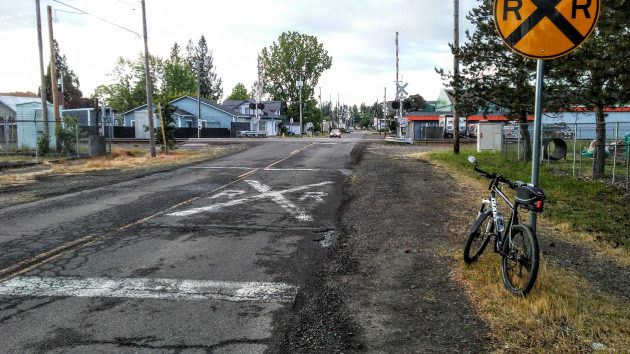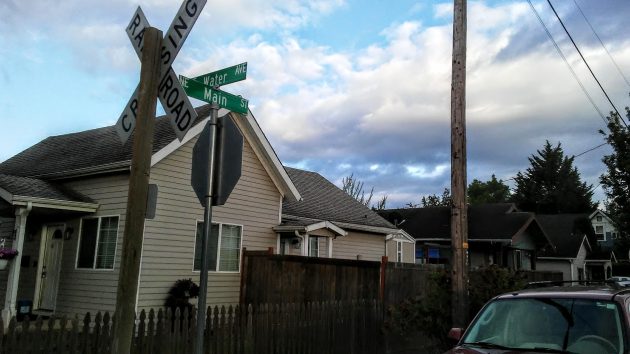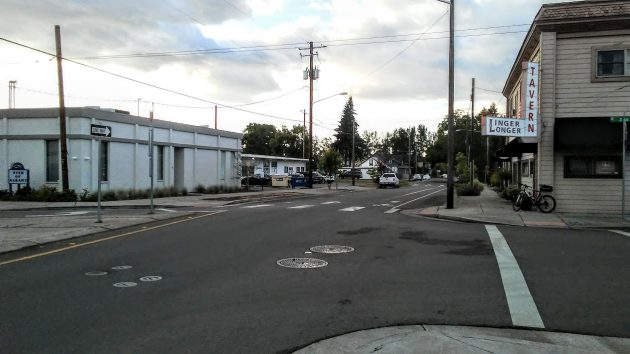
This part of Main doesn’t look like anyone’s idea of “Main Street,” does it?
A reader who moved to Albany last summer had a question: How come the city’s Main Street is nowhere near the downtown business district, where Main Streets are typically found in American towns?
Among the possibilities, he supposed, was that there had been another small town east of Albany for which that street really was a main street. And there, he had the answer to his question. Almost.
For the details, we turn to Bill Maddy and Erica Broad of the Albany Regional Museum.
As Maddy related it on a recent walking tour of the eastern part of old Albany, the gist of the story is that this district was settled in the 1840s by Abram Hackleman and others. They called the place Takenah, an Indian word for where the Calapooia flows into the Willamette. They also laid out streets and named them, including Main Street.
There was rivalry between Takenah and the settlement to the west, which the Monteiths named Albany for the New York capital where they were from. In 1853, Oregon’s territorial legislature picked Takenah as the town’s name, but in 1855 they changed their mind and settled on Albany.
(The word “settlers,” by the way, may be controversial now, considering that indigenous peoples had lived along the Willamette for millennia. In the new Oregon Blue Book out this year, the author of the state’s history uses “resettlers” to describe the American emigrants who arrived in the middle of the 19th century.)
It was the western sector that developed into downtown Albany. Old postcards of First Avenue sometimes mistakenly named it Main Street because that’s what it looked like to printers a world away. Turns out the cards were produced in Berlin.
In the old part of Albany from the river to Pacific Boulevard, Main Street has many faces today, not all as desolate as in the photo at the top. For example:

At the north end, the “Water/Main,” the street is lined by houses.

Here, the famous Linger Longer Tavern, closed now because of Covid, and Fish of Albany and Legacy Ballet on the other side.

The Main Street roundabout is only a few years old, but Whitaker’s has been here seemingly forever.
I spent Thursday evening cruising up and down this part of Main. Except when you pass the old church at the corner of Santiam Road, which a private group hopes to rescue and move, you don’t necessarily get the idea that this is a historic place. But it is. (hh)


Thanks. I often wondered about that. (And I kind of wish Takenah had won out as the city name—every state has an Albany, seems like.)
“Settlers” is the correct term: a person who moves with a group of others to live in a new country or area.
I suppose we might then refer to “undocumented immigrants’ from the south “settlers”; times change and folks move about seeking opportunity, safety, and wealth may be vilified or honored … depends on the perspective. Revisionist history sometimes corrects misguided assumptions, racism, misogyny, and misunderstandings.
I researched a few references regarding Albany’s namesake and Albany’s Main Street that are possibly worth sharing.
Howard McKinley Corning’s book: WILLAMETTE LANDINGS, writes an account of the village twenty two river miles above Salem. “Albany began as a village divided against herself, and was first named Takenah – a pleasant sounding word employed by the Indians to describe the large pool or depression created by the Calapooya River as it enters the Willamette from the East. But the habit of certain individuals of translating this into “hole in the ground” so oppressed the town that on petition of the citizens to the legislature of 1855 the name was changed to Albany; the choice was promoted by Thomas Montieth who previously had lived in “York State”.”
From the Editorial Page of The Oregon Daily Journal on June 5, 1939: THE OLD CANNON STARTED THUNDER, By B.F. Irvine. “Disappearance of a war cannon, at Albany, Oregon, started things to thundering during the last year of the Civil War. The cannon was stationed on a vacant lot on Main Street, where a side street led down to the ferry then used in crossing the Willamette River into Benton County.” “The disappearance set the city of Albany, and people more or less throughout the state, into an uproar, as the war spirit was then running very high. The secret of the disappearance was that a couple of distinguished Albany lawyers, and one or two other Southern sympathizers, ran the cannon down the incline to the ferry and onboard the ferryboat, moved the boat out into the middle of the river, and there rolled the cannon into the depths of the stream.”
Albany indeed has a past, and possibly a present, of being divided against herself.
Given the brutal treatment afforded the First Nations of the Willamette Valley, and to the entirety of North America’s indigenous people, perhaps Albany’s name should have been “Pillager.” It would make the City’s name a “Fun Fact of History” had it been so.
Of course, the Oregon legislature of the era was too busy drafting anti-Black and anti-Asian amendments to the constitution to be overly concerned with such simple things like town names or street monikers.
What some define as “settlers” would, if the same thing were to happen today, would be called marauding, thieving Visigoths…just sayin’
Hey Jake Hartman….please give your address so when I come across some marauding, thieving Visigoths I could direct them in your direction so you could accommodate them. Are “we” gonna reinvent history again as to the settling of the Willamette Valley.? Sh….t happens brother. How far back in history are you gonna go to “right wrongs”???
Amen.
Under-educated residents lacking a true understanding of the Willamette Valley native and EuroAmerican people’s history read up:
https://www.oregonencyclopedia.org/articles/willamette_valley_treaties/
https://libraryguides.lanecc.edu/kalapuya
It has nothing to do with under-educated anything. It’s simply a matter of realizing that what’s done is done and can’t be changed. Learn from it and move on. You can’t fix the past.
Often wondered why Main Street was distant from the core of downtown. It always seemed more peripheral than main. Thanks for the history lesson.
James Engel, sometimes “sh!+” does happen, but the catastrophic decline (70 to 90%) of the indigenous people due to the spread of highly contagious diseases to which they had no immunity; forced removal from their homelands which they’d occupied for at least fourteen thousand years to poorly managed, over-crowded reservations often accompanied by poor sanitation, great hardship, mistreatment, and violence; forced prohibition of their native spiritual and cultural practices; forced assimilation to European American ways of life and culture; and longstanding racial and cultural alienation, exclusion, discrimination, and oppression is volumes much much more than simply “sh!+”.
The only reinvention of Willamette Valley history to be concerned about is what’s been printed in state textbooks and taught in Oregon school’s curriculum for more than 150 years since the founding of the state until recently.
I think the City of Albany needs to create a Kiosk at the Montieth Park regarding the history of the Kalapuya Indians in the Albany area including the reason for their summer camp in Bryant park, to pick the wild canvas bulbs for food so new “Settlers” in Albany can learn our history.